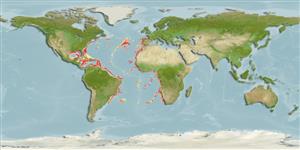Environment: milieu / climate zone / depth range / distribution range
Ecology
Marine; bathypelagic; depth range 500 - 2000 m (Ref. 4460). Deep-water; 45°N - 34°S, 98°W - 17°E
Eastern Atlantic: southern Bay of Biscay to Namibia. Western Atlantic: Gulf of Mexico, Caribbean, and off Brazil.
Size / Weight / Age
Maturity: Lm ? range ? - ? cm
Max length : 24.0 cm SL male/unsexed; (Ref. 4460)
Benthic on soft bottoms (Ref. 51024).
Life cycle and mating behavior
Maturity | Reproduction | Spawning | Eggs | Fecundity | Larvae
Markle, D.F. and J.-C. Quéro, 1984. Alepocephalidae (including Bathylaconidae, Bathyprionidae). p. 228-253. In P.J.P. Whitehead, M.-L. Bauchot, J.-C. Hureau, J. Nielsen and E. Tortonese (eds.) Fishes of the North-eastern Atlantic and the Mediterranean. UNESCO, Paris. Vol. 1. (Ref. 4736)
IUCN Red List Status (Ref. 130435: Version 2024-2)
Threat to humans
Harmless
Human uses
Tools
Special reports
Download XML
Internet sources
Estimates based on models
Preferred temperature (Ref.
123201): 3.9 - 9.9, mean 5.6 °C (based on 277 cells).
Phylogenetic diversity index (Ref.
82804): PD
50 = 0.5312 [Uniqueness, from 0.5 = low to 2.0 = high].
Bayesian length-weight: a=0.00347 (0.00163 - 0.00737), b=3.19 (3.00 - 3.38), in cm total length, based on LWR estimates for this (Sub)family-body shape (Ref.
93245).
Trophic level (Ref.
69278): 3.5 ±0.5 se; based on size and trophs of closest relatives
Resilience (Ref.
120179): Medium, minimum population doubling time 1.4 - 4.4 years (Preliminary K or Fecundity.).
Fishing Vulnerability (Ref.
59153): Low vulnerability (19 of 100).
